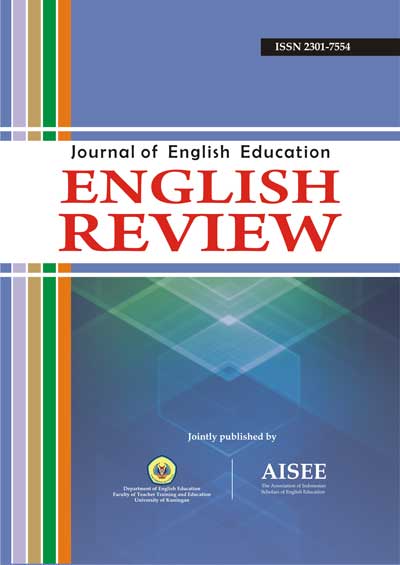THE PORTRAIT OF TEACHING ENGLISH AS A FOREIGN LANGUAGE FOR YOUNG LEARNERS
Abstract
Abstract: This observational study focuses on strategies used by teachers when teaching English as a Foreign Language to private international primary school students. This study attempted to address the following question: what instructional strategies are used by the English teachers at this school? The data collected by using a classroom observation and interview with teachers and students, were analyzed qualitatively by using categories formulated based on theories related to instructional strategies include planning and preparing the instruction, implementing the teaching and learning process, and assessing the students’ achievement. The major ï¬ndings of this study include 1) although the teachers do the same stages in planning but the plan is implemented and resulted in different ways; 2) the teachers are able to use games as a tool for learning; 3) although curriculum requires teachers to integrate the skills (reading, listening, writing, and speaking), in actual implementation, the teachers do not teach English in integrative ways; 4) time management in this school has become a problematic factor for the teachers; 5) with respect to teacher’s strategies in assessing students’ achievement, the teachers do assessment by way of remedial teaching once a week after the class is over in part where the students failed to understand.
Keywords: teaching English as a foreign language (EFL), learning process, teaching strategies, instructional strategies, assessment.
References
Alwasilah, A. C. (2000). Perspektif pendidikan bahasa inggris di Indonesia: Dalam konteks persaingan global. Bandung: Andira.
____________. (2002). Pokoknya kualitatif: Dasar-dasar merancang dan melakukan penelitian kualitatif. Bandung: Pustaka Jaya
Arikunto, S. 1990. Manajemen pengajaran secara manusiawi. Jakarta: PT. Rineka Cipta.
Brown, H. D. 2001. Teaching by Principles: an Interactive Approach to Language Pedagogy (2nd edition). New York: Pearson Education Company.
Carter, R. & Nunan, D. 2001. The cambridge guide to teaching english to speakers of other languages. New York: Cambridge University Press.
Djamarah, S.B & Zain, A. 2002. Strategi belajar mengajar. Jakarta: PT. Rineka Cipta
Harmer, J. 2002. The Practice of English Language Teaching (3rd Edition). England : Longman
Huda, N. 1999. Language Learning and Teaching. Issues and Trends. IKIP Malang Publisher.
Hudelson, S. 1991. EFL Teaching and Children: A Topic-Based Approach. English Teaching Forum. 29, 2-40.
Ibrahim, R. & Syaodih, N. 1996. Perencanaan pengajaran. Jakarta: PT. Rineka Cipta
Jarolimek, J. & Foster, J. 1989. Teaching and Learning in the Elementary School (4th Edition). Newyork: Macmilan Publishing Company.
Musthafa, B. 2002. EFL for Young Learners. Bandung: CREST.
Nicholls, G. 2002. Learning to teach: a handbook for primary and secondary teachers. london: Kogan Page Limited.
Nunan, D. 1988. The Learner-centred curriculum. New York: Cambridge University Press.
Nunan, D. & Lamb. C. 1996. The self-directed teacher: Managing the learning process. New York: Cambridge University Press.
Sadtono, E. 1997. The development of TEFL in Indonesia. IKIP Malang Publisher.
Setiyadi, B. Ag. 2006. Teaching english as a foreign language. Yogyakarta: Graha Ilmu.
Sinaga, Matias. 1994. Teaching english to children: as opposed to adults (p.173-178). The National Seminar: The Development of TEFL in Indonesia.
Suryosubroto, B. 2002. Proses belajar mengajar di sekolah. Bandung: Pt. Rineka Cipta.
Suyanto, Kasihani, K.E. 1994. Teaching english to young learners in indonesia (p.166-171). The National Seminar: The Development of TEFL in Indonesia.
Usman, U. 1990. Menjadi guru profesional. Bandung: Rosda Karya.
All articles published in English Review: Journal of English Education (ERJEE) are licensed under the Creative Commons Attribution 4.0 International License (CC BY 4.0).
Copyright Ownership
Authors retain the copyright of their articles and grant ERJEE the right of first publication. The journal is granted a non-exclusive license to publish, reproduce, and distribute the article in any format, medium, or platform, provided that proper credit is given to the original authors.
License Terms – CC BY 4.0
Under the Creative Commons Attribution 4.0 International License, others are free to:
- Share — copy and redistribute the material in any medium or format
- Adapt — remix, transform, and build upon the material for any purpose, even commercially
As long as they:
- Provide appropriate credit to the original author(s) and source
- Provide a link to the license (https://creativecommons.org/licenses/by/4.0/)
- Indicate if any changes were made
There are no restrictions on the reuse, reproduction, or adaptation of published articles as long as attribution is properly given.
Author Warranties
By submitting a manuscript to ERJEE, authors confirm that:
- The work is original and does not infringe any existing copyright.
- The manuscript has not been previously published and is not under consideration elsewhere.
- All sources and references are appropriately acknowledged.
- Necessary permissions have been obtained for any copyrighted materials used.










